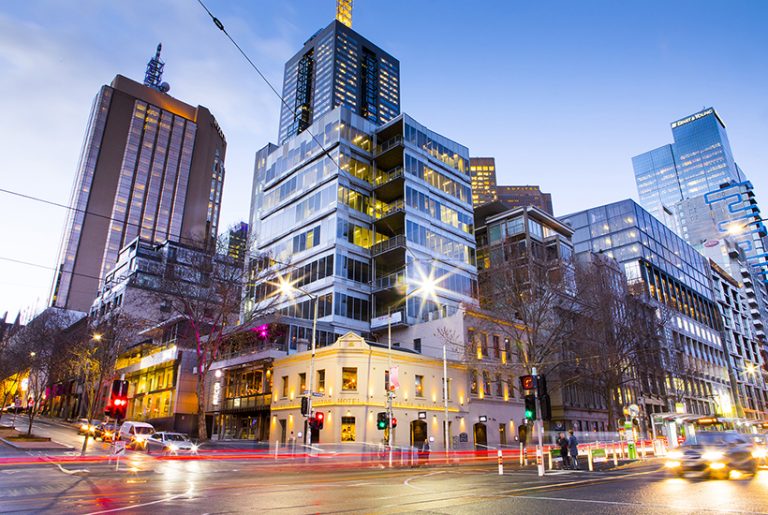The secrets of Melbourne’s first streets

Melbourne’s oldest street has been revealed as Flinders Lane.
But it started as a humble track that led to prime higher ground, used partly by modern Melbourne’s earliest settlers, who were there illegally, to keep a look out for authorities.
The bustling streets of Melbourne’s CBD, trams and hook turns all grew from tracks centred around Queen’s Wharf, where ships bringing supplies into the new settlement were unloaded.
Commercial Insights: Subscribe to receive the latest news and updates
Roads guru Dr Max Lay told one, where Flinders Lane is today, led to higher ground at Batman’s Hill, where pioneer John Batman had farmland.
“It was the track through the middle of the settlement, sort of thing, where locals could talk to each other and communicate together, and Batman was the boss and it was a good lookout,” he said.

Bourke Street between 1870-1890. Source: State Library of Victoria.

View along Collins St from Queen St looking east towards the Treasury Building. Source: State Library of Victoria.
“You could see what was coming because they were there a tad illegally. It was a good spot to make sure the troops weren’t coming.”
While this could be dubbed Melbourne’s oldest street, Dr Lay said “the first arterial road” was about the location of today’s City Rd, used to move between ships at Port Melbourne that couldn’t make it further up the Yarra and bending around lagoons along the way.
Batman’s Hill was used as the Hoddle Grid’s western boundary before it was later removed. Now, the Bunjil statue keeps watch amid booming development out towards Docklands.
The aquarium is a modern focal point at the historic turning basin, while the former Customs House, now the Immigration Museum, remains from Robert Russell’s 1844 sketch “Melbourne From The Falls.”
Collins St has remained the destination for high-end fashion since Robert Hoddle laid out his famous grid in 1836, bounded by Flinders, Spencer, Lonsdale and Spring streets.

Modern day Flinders Lane. Picture: Jake Nowakowski.

Melbourne’s oldest street has been identified as Flinders Lane between Market St and Spencer St. Picture: Jake Nowakowski.
Some of its first shops were draperies and haberdasheries, according to the Encyclopedia of Melbourne, which states haberdasher Michael Cashmore “arrived in 1840 with wares including … every variety of ready-made clothing, hats, bonnets, boots and shoes”.
Shoppers can now get the latest iPhone from the Elizabeth St corner site, before browsing international retailers including Tiffany & Co and Debenhams nearby.
Historian and author Robyn Annear said Flinders Lane was expected to become Melbourne’s “premier street” when the first land sale took place in 1837.
“But its reputation, I suspect, was quickly brought low by mud,” she said.
Through the 1840s Flinders Lane was notorious “as an often muddy, rutted and scarcely passable passage,” according to the encyclopledia.

Flinders Street Station circa 1908-1914. Source: State Library of Victoria.
“(But) by the 1860s … the street gained a reputation as a busy and important thoroughfare, the chosen location of mercantile houses, importers, brewers, timber yards and wholesalers.”
Now a foodie favourite, visitors are more likely to be dodging selfie-stick wielding tourists than workers lugging heavy goods in one of the city’s narrowest streets.
Colonial undersecretary Sir James Stephen could be considered unlucky — with Stephen St, named after him in the Hoddle Grid, long since renamed.
“After complaints from residents about the street’s unsavoury reputation as a location for prostitution, its name was officially changed to Exhibition St in 1898,” the encyclopedia states.
But for all its progress, one of Melbourne’s most iconic sites appears almost exactly the same as it did more than a century ago.
The fashion, cars and trams bustling in front of Flinders St Station’s clocks might have changed, but the landmark remains at its elegant best in its old age.
Meanwhile, skyrocketing property prices have been linked to the city since its very first land sales in 1837, when 100 half acres lots were sold.

Melbourne From The Falls by Robert Russell, 1837. Source: State Library of Victoria.

MelbourneFrom The Falls by Robert Russell, 1844. Source: State Library of Victoria.
Old Treasury Building general manager and Royal Historical Society of Victoria committee member Margaret Anderson said the most expensive was a block on the corner of Collins and Williams Streets, which sold for “the princely sum of £95.”
“The average price was £38. However, land values rose astonishingly quickly,” she said. “There was 500 per cent inflation over the next two years. One investor, Charles Ebden, bought a block in Collins St for £54 then sold it two years later for £5,000.”
The various waterways that intersect with what is now the City of Melbourne, including the Yarra River, known to indigenous Australians as Birrarung, are among the earliest known conduits of movement in the region.
For about 40,000 years, Aboriginal people moved through the landscape according to the seasons, often using the region’s major watercourses, with indigenous Kulin tracks across the area that is today Melbourne.
The Melbourne: Foundations of a City free exhibition tells the story of Melbourne to 1901 and is on at The Old Treasury Building.
This article from the Herald Sun originally appeared as “The story of Melbourne’s first streets”.







